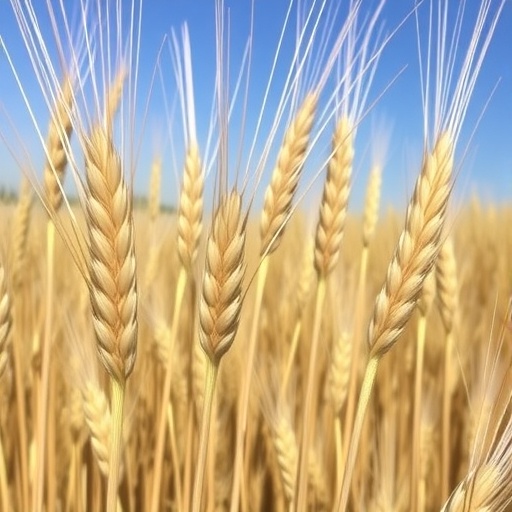Barley stands as one of the world’s foremost cereal crops, vital not only for livestock feed but also as a key ingredient in human food products and the malting industry that fuels the production of alcoholic beverages such as beer and whiskey. Despite its agricultural importance, barley cultivation faces persistent threats from a multitude of fungal diseases that undermine both the yield and quality of the harvest. In a recent groundbreaking study published in the esteemed journal Plant Disease, researchers from the University of Minnesota have unveiled a critical insight—foxtail barley (Hordeum jubatum), a wild grass species closely related to cultivated barley, can harbor a spectrum of fungal pathogens. This discovery sheds new light on the epidemiological dynamics of barley diseases and suggests that management strategies must extend beyond cultivated fields into surrounding natural ecosystems.
Foxtail barley is a resilient perennial grass native to North America, with a distribution spanning from the harsh climates of Alaska down to the temperate regions of central Mexico. It thrives ubiquitously across agricultural landscapes, native prairies, and disturbed environments, frequently growing adjacent to commercial barley fields. This proximity raises crucial questions about the potential role of H. jubatum as a reservoir for fungal pathogens, facilitating the persistence and spread of diseases affecting cultivated barley. To unravel this, the Minnesota research team embarked on a comprehensive pathosystem assessment, collecting 100 genetically diverse foxtail barley accessions from various North American regions, including Minnesota, Wisconsin, North Dakota, and Manitoba.
The study focused on evaluating the susceptibility of these wild grass accessions to seven predominant fungal pathogens known to cause significant diseases in cultivated barley. These pathogens included those responsible for net blotch, spot blotch, stem rust, stripe rust, crown rust, powdery mildew, and leaf rust. Comprehensive inoculation trials and detailed infection assessments were conducted to determine the extent of compatibility and disease manifestation in H. jubatum compared to barley cultivars with known resistance and susceptibility profiles.
Intriguingly, the results revealed no visual signs of infection on foxtail barley when challenged with powdery mildew and leaf rust pathogens, indicating a possible innate resistance or incompatibility with these fungi. However, a stark contrast emerged with the other five pathogens—net blotch, spot blotch, stem rust, stripe rust, and crown rust—where an overwhelming majority of the evaluated foxtail barley accessions (ranging from 97% to 100%) displayed infection. These findings underscore that while H. jubatum is not universally vulnerable to all barley fungal diseases, it exhibits significant compatibility with several key disease agents.
Moreover, the degree of susceptibility in foxtail barley to these five fungal diseases varied markedly among the accessions, spanning a continuum from levels comparable to resistant cultivated barley varieties to similar susceptibility seen in vulnerable cultivars. This variation points to a complex host-pathogen interaction landscape, possibly influenced by genetic heterogeneity within H. jubatum populations and pathogen strain diversity. The presence of susceptible wild grass individuals in proximity to barley crops could serve as critical inoculum sources, facilitating disease outbreaks by sustaining pathogen populations during off-seasons or suppressive environments for the pathogen in cultivated fields.
Such insights pivotally reshape our understanding of barley disease dynamics, emphasizing that control measures cannot remain isolated at the cultivated crop level. Instead, integrated disease management must consider alternative hosts in the surrounding landscape that may act as refuges or reservoirs for harmful pathogens. This ecological reservoir concept has broad implications in disease epidemiology, suggesting that surveillance and management strategies should encompass the broader agroecosystem rather than focusing solely on crop plants.
Additionally, the study highlights the broader significance of wild relatives in the epidemiology of crop diseases. Although wild species often offer genetic resources for breeding disease resistance, they may simultaneously harbor pathogens, creating a dual role that is critical yet underappreciated. The findings encourage future research on the genetic and biological mechanisms governing pathogen compatibility across species, creating pathways for breeding barley varieties that can withstand not only direct infection but also the indirect pressure exerted by surrounding pathogen reservoirs.
Furthermore, from an agricultural standpoint, understanding the spatial distribution and infection competency of foxtail barley accessions can inform targeted field management practices, such as buffer zones, eradication of susceptible wild populations near crop fields, or landscape-level disease monitoring. These strategies could markedly reduce the initial inoculum load that triggers epidemics, thereby safeguarding barley production and reducing reliance on fungicide inputs that carry economic and environmental costs.
The researchers also draw attention to the broader epidemiological framework where non-crop species play critical, yet often overlooked, roles in pathogen life cycles. By serving as hosts or carriers, alternative grasses like H. jubatum may impact disease persistence, emergence, and evolution, underscoring the necessity of adopting multi-host models in disease forecasting and risk assessment.
The University of Minnesota team’s findings serve as a vital reminder to the agricultural research community that plant disease management is inherently multidisciplinary, requiring collaboration between plant pathologists, ecologists, agronomists, and landscape managers. Developing disease-resistant barley cultivars, optimizing cultural practices, and conserving beneficial biodiversity must be balanced with controlling pathogen reservoirs in natural vegetation to achieve sustainable crop health.
In conclusion, the identification of foxtail barley as a reservoir host for multiple fungal pathogens attacking cultivated barley challenges existing paradigms in agronomic disease management. This research not only expands the biological understanding of host-pathogen interactions in cereal crops but also calls for innovative, ecosystem-level approaches to crop protection. As global food security faces increasing threats from emerging plant diseases and changing climate conditions, such comprehensive insights into disease epidemiology are indispensable. Agricultural stakeholders, policymakers, and researchers alike must heed the importance of alternative hosts to devise holistic and effective disease mitigation strategies that ensure resilient barley production systems for the future.
Subject of Research: Hordeum jubatum as an alternative host for fungal pathogens affecting cultivated barley.
Article Title: Hordeum jubatum: An Alternative Host for Fungal Pathogens Attacking Cultivated Barley
News Publication Date: 22-Sep-2025
Web References: https://doi.org/10.1094/PDIS-03-25-0472-RE
References: University of Minnesota research, Plant Disease journal article, 2025
Image Credits: Brian J. Steffenson
Keywords: Agriculture, Fungal pathogens, Pathogens, Crop science, Grasses, Plant pathology




